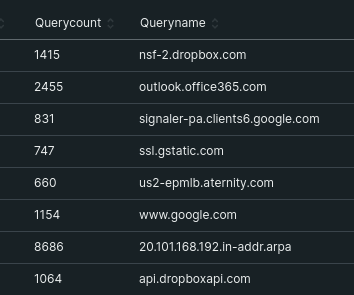(This post originally appeared on AdatoSystems.com)
DBA Mary extraordinary,
What makes your tables grow?
When queries propel, through my TSQL shell
data ingests into into neat little rows.
This will likely be the last post in my series about monitoring the pihole DNS server. You can find part 1, "Your Pi-Hole is a Rich Source of Data", here, and part 2, "Mind the Gap", here. If you've been reading along it should be clear that this is not so much about the pihole in particular as it is about ways New Relic allows you to manipulate observability data. The truth is that the pihole provided me with a number of great examples of the different ways data can present itself out of various systems.
With that said, in this post I'm going to address a situation that happens a lot with JSON output - data that should be recorded as sequential rows under a single field, but instead ends up splitting across multiple fields.
I'm going to continue to leverage the pihole for this example. In the previous post, all of our attention was focused on the output of a single API endpoint: ?summaryRaw. But the pihole has many other endpoints that emit data, including:
- topItems=xx - show the xx top domains and top advertisers being requested.
- topClients=xx - show the top sources of DNS queries within your network.
- getForwardDestinations - Show the external DNS servers where DNS queries are going once they bounce out of your network.
- getQueryTypes - Show the volumn of each type of DNS query (A, AAAA, PTR, SRV, etc).
(You can read about all the possible API endpoints in this post.).
So let's consider a Flex integration that is set up to gather some of the information I've identified above:
integrations:
- name: nri-flex
config:
name: badpihole
apis:
- name: badpihole_querytypes
url: http://pi.hole/admin/api.php?getQueryTypes&auth=abcdefg1234567890 #your auth key goes here
headers:
accept: application/json
(Note that I've purposely named the elements "bad" so you can find them, because ultimately I don't think they are valuable in the current format)
transforming columns into rows
When you look at it in NRQL, you'll see a result like this:
The issue becomes even worse when the results are highly variable. For example, "topItems" will return the top domains and advertisers for a given period. While that MIGHT remain somewhat consistent, in larger or more dynamic networks that list can change drastically.
So with the YAML element of:
- name: badpihole_topitems
url: http://pi.hole/admin/api.php?topItems=10&auth=abcdefg1234567890 #your auth key goes here
headers:
accept: application/json
You could see your column count go up moment by moment:
What's needed is to transform the incoming data so that rather than appearing like this:
"top_ads.unity3d.com": 54,
"top_ads.display.ravm.tv": 90,
"top_ads.hbopenbid.pubmatic.com": 49,
Instead, it's re-organized into a format more like this:
Name: "top_ads.display.ravm.tv",
Count: 90,
Name: "top_ads.display.ravm.tv"
Count: 90,
Name: "top_ads.hbopenbid.pubmatic.com"
Count: 49,
The result of which looks like this when displayed in New Relic:
Phenomenal cosmic power, itty bitty command
How is this transformation achieved? Through a remarkably simple use of the jq utility. I mentioned jq in part 2 of this series, where the usage was far more complex.
As so often happens in tech, what we're asking for is a much more complex operation, and yet the structure is way easier to understand:
jq: >
.[]|.top_queries|to_entries|map({queryname:.key,querycount:.value})
As with the jq wizardry in my last post, this is largely due to the genius of my colleague Haihong Ren. Putting this line into the context of a complete Flex YAML file, it would look like this:
integrations:
- name: nri-flex
config:
name: pihole
apis:
- name: pihole_topitems
url: http://pi.hole/admin/api.php?topItems=10&auth=abcdefg1234567890 #your auth key goes here
headers:
accept: application/json
jq: >
.[]|.top_queries|to_entries|map({queryname:.key,querycount:.value})
The result of which, as I showed earlier, is data that is easier to summarize, query, sort, select, and display.
Special bonus clip-and-save section
There's not really much to summarize here, except to underscore that New Relic's platform is not only flexible enough to enable you to collect just about any type of telemetry you need; but to also manipulate it so you can transform data into information, which drives thoughtful action within your organization.
If you'd like to try out this entire thing for yourself, but would prefer not having to BUILD it all yourself (and in this, I applaud your commitment to economy of effort) then below you will find the complete YAML file. And here is a link to a quickstart with the dashboard pictured above.
integrations:
- name: nri-flex
config:
name: pihole
variable_store:
authkey: abcdefg1234567890 #your auth key goes here
# In order for this integration to work, you need to include your pihole API key.
# You can get the token by loggin into your pihole and going to Settings/API/Show API token
# or by connecting directly to the pihole device and getting the WEBPASSWORD variable from /etc/pihole/setupVars.conf
apis:
- name: pihole_summary
url: http://pi.hole/admin/api.php?summaryRaw&auth=${var:authkey}
headers:
accept: application/json
- name: pihole_topitems
url: http://pi.hole/admin/api.php?topItems=10&auth=${var:authkey}
headers:
accept: application/json
jq: >
.[]|.top_queries|to_entries|map({queryname:.key,querycount:.value})
- name: pihole_topclients
url: http://pi.hole/admin/api.php?topClients=10&auth=${var:authkey}
headers:
accept: application/json
jq: >
.[]|.top_sources|to_entries|map({clientname:.key,clientcount:.value})
- name: pihole_toforwarddest
url: http://pi.hole/admin/api.php?getForwardDestinations&auth=${var:authkey}
headers:
accept: application/json
jq: >
.[]|.forward_destinations|to_entries|map({destinationname:.key,destinationcount:.value})
- name: pihole_querytypes
url: http://pi.hole/admin/api.php?getQueryTypes&auth=${var:authkey}
headers:
accept: application/json
jq: >
.[]|.querytypes|to_entries|map({querytype:.key,querycount:.value})
- name: pihole_recentblocked
url: http://pi.hole/admin/api.php?recentBlocked&auth=${var:authkey}
headers:
accept: application/json











Top comments (0)